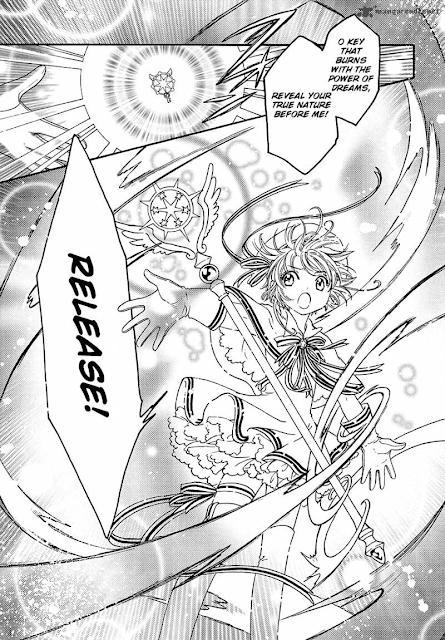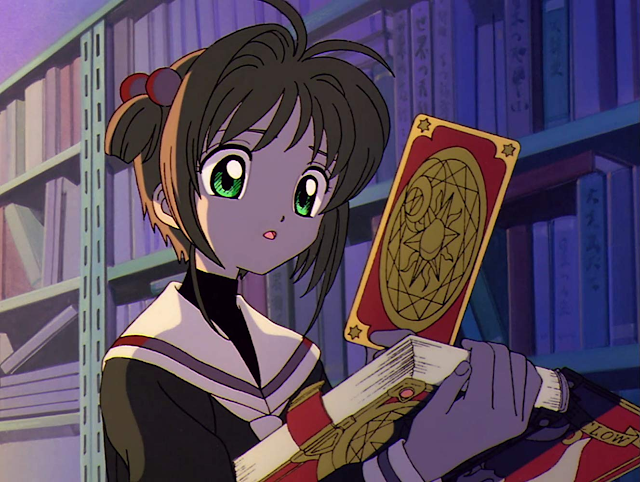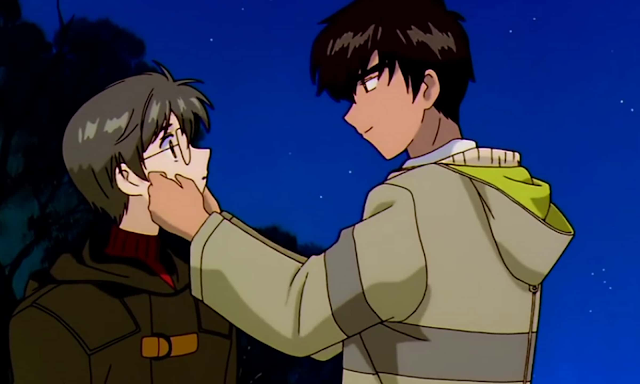WB, June 17, 2000-December 14, 2001 US
Teletoon, August 23, 2000-March 8, 2003 CAN)
CLAMP is an all-female Japanese manga artist
collective, or “circle”, founded in the mid-1980s. Currently comprised of
leader and writer Nanase Ohkawa,
and artists Mokona Apapa
(who just goes by Mokona), Mick
Nekoi (now known as Tsubaki Nekoi) and Satsuki Igarashi,
they had also featured founding members O-Kyon, Sei Nanao (who both left by
1990), Tamayo Akiyama,
Leeza Sei (who
both left in 1992), Sōshi Hishika, Kazue Nakamori and Shinya Ōmi (who all left
in 1993). The group’s name came from the dictionary when they needed something alphabetically
close to “CLUB/Y” to remain seated near a prominent artist at an exhibition. They
started out creating dōjinshi (fan comics) of Captain Tsubasa,
Saint Seiya, and
Jojo’s
Bizarre Adventure before pivoting towards original work in 1987.
Their first original project was RG Veda, which got them
approached by an editor for Shinshokan’s
Wings manga magazine
about working for them. RG Veda ended up being serialized in Wings;
starting out a single story but expanded when sales and reader response were
higher than expected. Over the next decade, they would find themselves
published in various magazines and by various publishers. Nakayoshi magazine, published
by Kodansha, wanted CLAMP to produce
another series for them as their current one, Magic Knight
Rayearth, was about to wrap up. Ohkawa wanted to create a magical girl
series, despite not being well-versed in the genre, in order to have a
character roughly the age of Nakayoshi’s readership (the magazine was
targeted towards young girls) that they could relate to. They came up with Cardcaptor
Sakura, a title suggested by Nekoi. It debuted in May of 1996 and ran until
June of 2000.
The manga would focus on the
titular Sakura Kinomoto, a 10-year-old girl who ended up accidentally releasing
19 magical Clow Cards
(named after their former owner, sorcerer Clow Reed) from
a book found in her
family’s basement and was tasked with retrieving them. It would prove to be
different than all of CLAMP’s other series to date as it had a more hopeful
feeling to it with the theme of “if you try your best, it’ll work out”.
Additionally, there was a focus on various forms of love and relationships
between the characters without commentary, which sometimes took center stage
over the main plotline in various chapters. Artists Mokona, Nekoi and Igarashi
were asked by Ohkawa to use thin and curved lines and to keep the pages light
without a lot of ink to give the story a “soft, cute-like” feel. Additionally,
a lot of flower imagery was incorporated (while avoiding roses). While the
series continued the trope of standard magical girl transformation scenes in
the manga, CLAMP wanted Sakura to have different costumes as they felt “it’s
pretty sad for a girl to wear the same outfit all the time.”
The manga’s popularity spurred the
production of tie-in media, which included video games, art books and an
anime. The anime was produced by Madhouse
and directed by Morio Asaka,
with Ohkawa serving as head writer and Mokona overseeing costume and card designs.
Other writers included Hiroshi
Ishii, Jiro
Kaneko, Tomoko
Ogawa and Tomoyasu
Okubo. Katsufumi
Hariu handled art direction with Kumiko Takahashi
on character designs and Takayuki Negishi
on music. It aired 70 episodes across three seasons on NHK BS2 from April 7, 1998-March 21, 2000, as
well as two movies released by Bandai that
bridged between the first two seasons and served as the series finale. Despite
airing in a traditionally poor timeslot, the anime proved popular with viewers
and won the Animage Grand Prix award for
best anime in 1999.
As with the manga, the anime
centered on elementary school student Sakura Kinomoto (Sakura Tange) and her
quest to recover the now 52 Clow Cards, created by half-English, half-Chinese
sorcerer Clow Reed (Kazuo
Hayashi), before they wreaked havoc in the fictional Japanese town of
Tomoeda. She was an extremely sweet and energetic girl who was athletically
gifted in sports but a bit clumsy and naïve in life. She was also unaware that
she possessed any kind of magical ability until it was revealed that was the
only way she could have broken the seal on the Clow Book to free the cards. The
cards themselves had their own personalities ranging from good to malicious, as
well as an alternate form. They possessed powers typically embodying an
elemental force or related to a specific task as well as an ability to float,
and could possess objects and control people through them. In order to defeat a
Clow Card, their power had to be bound by someone signing their name at the
bottom of the card, signifying they are the card’s new owner. Once Sakura
captured a card, she was able to use its abilities when needed. Her primary
weapon was a staff called the Sealing Wand, which
shrank into a key Sakura wore around her neck until a magical chant was
recited. It gave the wielder the ability to seal or summon Clow Cards.
Guiding her on her mission was one
of the cards’ guardians, Cerberus (Aya Hisakawa), also called “Kero” after the
Greek version of his name, Kerberos. His primary form was that of a small
winged cat-like cub with a lion-like tail, while his true from (voiced by
Masaya Onosaka) was that of a large mountain lion with giant angelic wings and
armor. Cerberus was bossy, demanding and gluttonous, but cared about Sakura and
believed in her ability to accomplish her quest. Also helping wherever she
could was Sakura’s best friend and second cousin, Tomoyo Daidouji (Junko Iwao).
She would follow Sakura around with her video camera to record all her
exploits, as well as designed new costumes for her to wear into battle and
helped cover for her dual identity. Mature for her age, she gave off an air of
refinement while still being very sweet and caring. Her ability to sing often
made her the target of Voice and Song cards. Additionally, Sakura’s older
brother, Touya (Tomokazu Seki), had an ability that allowed him to sense when
his sister was in danger and did what he could to protect her, all the while
keeping his knowledge of her double life to himself.
A second Cardcaptor was introduced
in the form of Syaoran Li (Motoko Kumai), a cold and cynical boy from Hong Kong
who was descended from Reed and a member of the Li clan of sorcerers. He
believed he should inherit the cards over Sakura and sought to capture them for
himself, often being antagonistic towards her and criticizing her flaws.
However, the more time he spent with her, the more he warmed up to and
eventually even developed feelings towards her, deciding to work with her in
capturing the cards. To find the cards, he utilized a special compass
created by Reed. Trying to help Syaoran was his first cousin and betrothed (in
Japan, first cousins are allowed to marry), Meiling Li (Nogami Yukana), who was
an original character in the anime. She possessed no magical ability herself
which often led to her hindering Syaoran more than helping, despite being
proficient in martial arts. While in Tomoeda, Syaoran and Meiling were watched
over by family butler Wang
Wei (Motomu Kiyokawa),
who was also created for the anime.
Additionally, there was Yukito
Tsukishiro (Megumi Ogata), who was Touya’s best friend and whom Sakura
initially had a crush on. Yukito had a kind and gentle personality, and was
very popular in school. He was also a complete lie as it turned out he was
unknowingly nothing but a false form for the other card guardian, Yue. Yue had
an angelic appearance with dark armor, and was in charge of judging if the next
Master of the Clow was worthy. Despite his cold demeanor, he had a kind heart.
His powers were reliant on those of his master, and Sakura had to build hers up
in order to sustain him. It would be this revelation that would explain
Syaoran’s own attraction to Yukito; originally mistaken as being a crush but
actually he was drawn towards the magical energies hidden within.
Other characters included Fujitaka Kinomoto
(Hideyuki Tanaka), the
widowed father of Sakura and Touya; Nadeshiko Kinomoto
(Yūko Minaguchi), the
deceased mother of Sakura and Touya who went against the wishes of her family
when she married Fujitaka; Sonomi Daidouji (Miki Itō),
Tomoyo’s wealthy mother and cousin of Nadeshiko who such deep romantic feelings
for her that she considered Fujitaka a rival; Yoshiyuki Terada (Tōru Furusawa & Katsuyuki Konishi), a teacher
at the elementary school who taught several classes and often chaperoned trips;
Rika Sasaki (Tomoko Kawakami), Sakura’s mature
yet shy classmate and friend who regarded Yoshiyuki as a father figure; Takashi Yamazaki (Issei Miyazaki), another
classmate who was known for creating highly-detailed fabricated stories on just
about any subject; Chiharu
Mihara (Miwa Matsumoto),
a cheerleader who was close friends with Takashi and often playfully strangled
him to stop one of his stories; Naoko Yanagisawa (Emi Motoi), a cheerleader---despite
being bad at gymnastics--with a love of fantasy and ghost stories; and Kaho Mizuki (Emi Shinohara), a shrine maiden that dated Touya
before leaving to study in England, who returned as a substitute teacher that
Sakura developed a crush on and seemed to have some knowledge in regards to the
Clow Cards.
After Sakura managed to reacquire all
of the cards and passed Yue’s judgement, her staff changed from having a
bird-like head to a
star with wings and give her the ability to convert the Clow Cards into Sakura Cards. Eriol Hiiragizawa
(Nozomu Sasaki), the
reincarnation of Reed, came to town and created a series of magical disasters
in order to force Sakura to do so as the cards could only maintain their power
by feeding off of their master’s magic. In the guise of a child, he attended
Sakura’s school and befriended her and Takashi. Assisting Eriol were two new
guardians he created: Spinel
Sun (Yumi Touma), whose
borrowed form resembled that of a cat with butterfly wings and true form
(Konishi) was that of a panther with butterfly wings and butterfly-shaped
armor, and Ruby Moon (Ryoka Yuzuki), who resembled a
human-sized fairy with butterfly wings, and assumed the form of high school
student Nakuru
Akizuki out of boredom. Both were the opposites of their fellow guardians,
with Spinel being calm and well-read while Ruby was more chaotic, always
teasing Spinel and proving a general nuisance to Touya in school.
As the manga was still ongoing at
the time, naturally the anime wasn’t a straightforward adaptation and several
changes were made. The series began with Sakura’s releasing of the Cards,
whereas the manga had depicted it in flashback after she was already on her
quest. Along with the number of Clow Cards, their capture happened in a
different order and sometimes at different locations and times of day. Cerberus
needed both The Earthy
and The Firey cards to
return to his original form, rather than just the Firey. Syaoran was made able
to activate the cards he owned via his sword, took part in Yue’s final
judgement, and was no longer living on his own. The fact that Sakura’s father
was created from half of Reed’s soul was omitted, eliminating his resistance to
the cards’ magic and his ability to see the spirit of his late wife, and making
Eriol the only aspect of the sorcerer. The Moon Bell created by Reed
to transform Sakura’s staff was meant to help her defeat Yue without hurting
him, but was used to give Sakura a second chance to pass his final judgement in
the anime.
Several relationships in the anime
were altered from their presentation in the manga. Kaho and Eriol were revealed
to know each other, but don’t end up together romantically. Rika and Terada’s
relationship skewed uncomfortably more towards the romantic in the manga, with
the pair planning on getting engaged once Rika was old enough. Sakura was the
only one who really knew of their relationship and often came to Rika for
advice with her own love life. Chiharu and Takashi’s relationship was left
ambiguous, and Tomoyo having unrequited romantic feelings towards Sakura were
downplayed. Syaoran confessed his feelings to Sakura immediately after the
final battle and tried to hide the fact he was ordered back to Hong Kong by his
mother, and he ended up absorbed by The Nothing card when
she tried to reciprocate.
As anime was gaining in popularity
outside of Japan, Cardcaptor Sakura was licensed out for localization in
other markets. For the English-speaking markets, three different companies
created their own dubs independently of each other. Animax Asia’s dub was used for Southeast
Asia. The version to air in North America and Australia was handled by Canadian
company Nelvana in association with The Ocean Group, which included the first film. The second film, often
considered the 25th episode of the third season and the series
finale of the anime, was done by Bang
Zoom! Entertainment.
Nelvana spent roughly $100,000 per
episode on translation by Meredith Woodward, dubbing, and incorporating new
music composed by Lenz
Entertainment, as well sound effects when the originals couldn’t be
isolated from audio tracks. As with other anime imports, a number of changes
were made to bring the series more in line with Western sensibilities at the
time. For instance, elements of Japanese culture, signage and landmarks were
either altered to something more familiar to the target audience or eliminated
entirely when possible. All of the children, which were mostly polite and
soft-spoken, were made to be far more outspoken; particularly Sakura herself as
she was depicted as more assertive. The characters’ names were also mostly Westernized:
Sakura became Sakura Avalon (with a different pronunciation for her first name
which was only kept because it would have been too difficult to remove all
instances of it, voiced by Carly McKillip); Cerberus became Keroberos (Matt
Hill using a New York accent, and Richard Newman for his true form) and
retained his Kero nickname; Tomoyo became Madison Taylor (Maggie Blue O’Hara,
using a valley girl accent instead of the elegant style from the anime); Touya
became Tori Avalon (Tony Sampson); Yukito became Julian Star (although Yue’s
remained unchanged, both voiced by Samuel Vincent); Syaoran became Li Showron
(Rhys Huber & Jordan Kilik); Meiling became Meilin Rae (Nicole Oliver);
Reed’s name was pronounced as “klau” instead of “klo” (Dale Wilson); Fujitaka became
Aiden Avalon (Brian Drummond),
and his wife, Natasha (Janyse
Jaud); Sonomi became Samantha Taylor (Venus Terzo); Yoshiyuki was
addressed as simply Mr. Terada (Drummond); Rika became Rita (Dina Sherman); Takashi became
Zachary Marker (Philip Pacaud);
Chiharu became Chelsea (Jocelyne
Loewen); Naoko became Nikki (Kelly
Sheridan); Kaho became Layla MacKenzie (Linda Rae Jurgens); Eriol
became Eli Moon (Bill Switzer);
Spinel Sun became Spinner Sun (Colin
Murdock); and while Ruby Moon (Willow Johnson) kept her name,
her alternate form went by it as well. The town itself was also renamed
Reedington.
Boys were determined to be the
larger demographic for animation, just like it was determined that girls were
more likely to watch shows targeted for boys than the reverse. Nelvana’s dub
tried to make the show as appealing for boys as possible by toning down
anything deemed “girly”. Sakura’s name was removed from the title, becoming
simply Cardcaptors; its plurality done to indicate Li’s elevation from a
supporting character to a central protagonist alongside Sakura in order to give
boys a character they could relate to. The episodes were reorganized so that
Li’s debut episode was the first and that more Li-centric episodes aired early
on, creating plot holes and inconsistencies in the overall story. While the
final episode remained in its correct place chronologically, it was combined
with the preceding episode and eliminated most of the romantic moments between
him and Sakura. Since Pokémon and Yu-Gi-Oh! were the big shows at
the time, it was decided to veer away from cutesy and slice of life moments and
put an emphasis on the card collecting (as collecting was the big hook in those
other shows) and the action and adventure.
That meant romantic entanglements
were removed as much as possible, with the central romance between Sakura and
Li being drastically downplayed to the point that their love for each other was
never confessed and the series ended with Li simply returning home. Problematic
relationships were outright eliminated; such as teacher/student relationships
like Sakura’s father being a teacher at the high school her mother attended,
the remaining traces of Rita and Mr. Terada’s forbidden flirtations, and Tori’s
brief fling with student teacher Layla, and ones with an incestuous tone, such
as Meilin becoming a childhood friend of Li with a crush on him rather than his
cousin. Chelsea was also turned into Zachary’s cousin, removing all possibility
of their being a couple and her “strangling” him being given a twinge of
sibling energy. Additionally, the price for Sakura failing the final judgement
was changed from everyone connected to the cards losing their love for the
person they cared for most to everyone’s memory being erased from the time the
cards were released. The reason the cards needed to be changed to Sakura Cards
(Star Cards in the dub) was altered to their needing a reliable magical source
to survive on unless they ran wild looking for one and potentially destroyed
the world.
It particularly meant the elimination of any queer relationships, of which the manga featured many and the anime carried over in some form. Li was no longer attracted to Julian (magical influence or not), with his reactions to him being explained away as being off-put by his general personality. Julian and Tori were no longer attracted to each other and just remained the good friends they were initially depicted as. Madison and Samantha both lost their attractions to their respective cousins. In fact, Natasha’s familial connection to Samantha was removed altogether to make them just friends, and Samantha’s dislike of Aiden came from her feeling like a third wheel when they got together rather than romantic rivalry. Sakura’s crush on Julian, which was prominent throughout the early half of the series, was also downplayed.
Cardcaptors debuted on The WB as part of the Kids’ WB programming block
on June 17, 2000 in the United States, while Teletoon (now Cartoon Network) in Canada started
airing it on August 23, 2000 (along with a French dub). While all 70 episodes
were dubbed, further edits were made to the American version of the program.
The series was cut down to only 39 episodes—particularly eliminating ones that
didn’t center on Li—with Li’s first episode, the anime’s 8th, being
aired first to introduce him right away. Scenes were removed and replaced with
ones from other episodes, particularly ones focused on card collecting. To
further emphasize Li’s prominence, Kids’ WB’s promotions painted Li as the main
character and reduced Sakura to a secondary one. The episode title cards were
changed to include a CGI rendering of the Clow Book opening, which was also
featured in the original Nelvana intro. The three themes, while simply
translated in the original dub, was changed to more of a rocking one about
action and adventure performed by Dave
Doré. Retained at the end of the episodes was a special short segment
called “Leave
it to Kero-Chan!”, or “Kero’s Corner” in the dub, where Kero would recap
the episode and introduce a character to the audience.
The episodes “Sakura and Kero’s Big
Fight” and “The Summer House” never aired in North America; likely due to the plot
of Kero getting drunk being central in the former and Sakura befriending an old
man and going over to his house in the latter (despite the fact the old man
turned out to be her great-grandfather). Instead, two Kids’ WB-exclusive
episodes, “The Past, The Present and the Future” and “A Strange New Beginning”
which were combinations of different episodes from the anime, were aired in
their place to round out the full 70-episode run. These were the only American episodes
to air outside of the country, and were omitted from later reruns of the
Nelvana series. The Bang Zoom! dub of the second film would ignore all of
Nelvana’s changes and adhered closely to the original Japanese production
utilizing a different English voice cast.
Merchandising for the series
included a
line of toys by Trendmasters.
Action figures of Li, Mei Lin and Sakura in different outfits were released
alongside fashion dolls of those characters with cloth clothing, figurines
of Li, Sakura and Kero, a talking Kero doll, and a set of keychains.
Additionally, a roleplaying Clow Book and Clow Cards set and Sakura’s wand were
released. Tokyopop produced a series of 10 cine-mangas adapting
various episodes using stills from the anime. When they were translated into
English, the dub’s names and personalities were carried over and the books were
retitled Cardcaptors.
Scholastic published several
easy-reader adaptations of various episodes, a sticker book and a tattoo scrap
book, while Landoll released three punch-out activity books. As
part of the promotion for the English dub in 2002, four toys
were released through Taco Bell
restaurants. Once again, Li was put in a place of prominence as he was the only
character physically represented in the toys—the others being Madison’s
camcorder with a Sakura sticker and an episode still inside, Li’s compass
(called a Lasin Board in the dub), and the Clow book which contained 20 Clow
Cards—while Sakura was only seen on the advertising. Kero was featured as a small
plush for the younger kids. The restaurant came under
fire by religious groups as they felt the Clow Cards looked too close to
tarot cards, which represented the occult. Taco Bell issued an apology and
ended their distribution shortly after. Pioneer Entertainment released
the first 27 episodes of Cardcaptors on 9 VHS and DVD compilations
between 2000 and 2002, as well as the
first film. A 10th volume was planned but ultimately
cancelled. Rhino Entertainment released
the album Cardcaptors:
Songs from the Hit TV Series in 2001. While the original anime has been
made available to stream on Crunchyroll,
Netflix, Tubi,
Prime,
Google
Play and Apple
TV, the Nelvana dub could only be found from fan uploads on YouTube.
Alternate versions of some of Sakura’s
characters appeared in CLAMP’s Tsubasa:
Reservoir Chronicle manga in a crossover with some of their other
characters. It was published in Weekly
Shonen Magazine from May 2003 through October 2009. In 2016, CLAMP
began a sequel to Sakura subtitled Clear
Card that is, as of this writing, currently ongoing. It follows Sakura,
Syaoran and their friends into junior high school as they try to figure out why
the Sakura Cards have turned blank, rendering them powerless. As with the
original manga, Madhouse adapted the first 28 chapters of Clear Card
with the same staff and cast returning; with the exception of Kunihiko Hamda coming on as
character designer. A follow-up anime was
announced in 2023 that will adapt the rest of the series until its
conclusion. Bushiroad and Monster Lab
also created a mobile
game that was in service from October 2019 through June 2020.















No comments:
Post a Comment